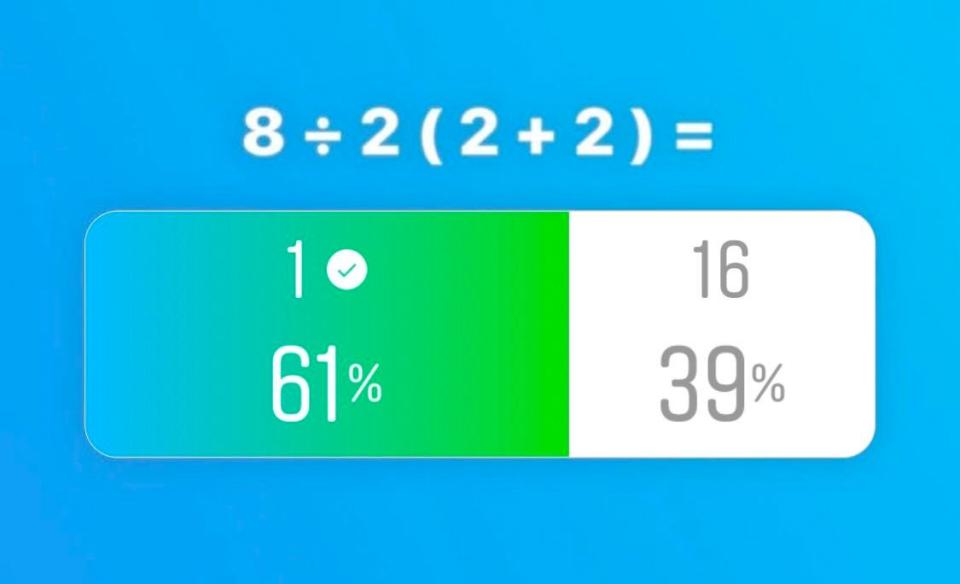This Simple Math Has Twitter Totally Stumped

There it appeared on Twitter, like a cruel taunt:
oomfies solve this pic.twitter.com/0RO5zTJjKk
— em ♥︎ (@pjmdolI) July 28, 2019
Every few months, the Internet eats itself over some kind of viral riddle or illusion, each more infuriating than the last. And so, like clockwork, this maddening math problem has gone viral, following in the grand tradition of such traumatic events as The Dress and Yanny/Laurel.
These kinds of conundrums are purposely meant to divide and conquer, and predictably, the seemingly simple problem posed in the offending tweet—8÷2(2+2)—practically caused a civil war in the Popular Mechanics office, which we also share with our (former) friends at Runner’s World and Bicycling magazines.
Naturally, we took to Slack to hash out our differences. Here’s a heated chat between the editors who stopped doing any semblance of actual work for the day to solve an equation designed to flummox fourth graders—and make many enemies in the process—followed by insight from real mathematicians and physicists who begrudgingly responded to our request for comment to solve the enraging math debate, once and for all.
The Slack War, Part I
Derek Call, video producer: 8 divided by 8 is 1.
Jeff Dengate, Runner’s World runner-in-chief: PEMDAS. 16.
Bobby Lea, test editor (and three-time Olympic cyclist): i ride bikes
Matt Allyn, features director: for anyone that wants a longer explanation of why you divide before multiply in this case
Pat Heine, video producer: ...she writes out PEMDAS and then does PEDMAS
Matt: you clearly didn't listen
Pat: i didn't...i was busy correcting her math.
Derek: When they reinvent math?
Matt: ok, Derek, the video's for you
Pat: if you get 16 it's because you don't know the difference between brackets and parentheses.

Morgan Petruny, test editor: I agree with Derek and disagree with YouTube. What if you want to do it the long way and use the distributive property and distribute the 2 first? You would do: 8 / (4+4) = 1.
Or does the distributive property suddenly no longer apply?
That's what I would say proves that 1 is correct.
Derek: I trust Morgan because she's had a math class this decade.
Pat: Wikipedia says you hate America if you get 16.

Dan Roe, test editor: Right but it's multiplication/division, not multiplication then division
Morgan: BUT multiplication with parentheses trumps division. So you still have 8 / 2(4). So you have to do the 2x4 first. At least, that is what I was taught.
Dan: smart Berkley people say it's too ambiguous to say; PEMDAS isn't a mathematical convention as much as a teaching method
Pat: multiplication/division::right/wrong
Taylor Rojek, associate features editor: Biggest takeaway isn't that anyone sucks at doing math, but that this person sucks at writing out clear equations
Bill Strickland, editorial director: MAKE IT CONTENT!
instagram story with our staff debating?
can we call a famous mathematician?
Bobby: This sounds like a conversation the belongs on the Not My Job segment of Wait Wait Don't Tell Me
Katie Fogel, social media editor: polling our IG audience on this now...
Pat: The equation is not written according to ISO standards, leaving ambiguity of interpretation and the real answer is we need to teach better math writing.
Ambiguous PEMDAS
Ambiguous problems, order of operations, PEMDAS, BEMDAS, BEDMAS
aka...what Taylor said, but from Harvard
Morgan: aka...teach the distributive property instead of random acronyms
Pat: When written according to ISO standard, the answer is 1.

Andrew Daniels, how-to editor: honestly, we could post this slack thread word for word and then get a scholar to chime in and school us
Katie Fogel: From our IG audience...

Kit Fox, special projects editor: Isn’t the question and ambiguity here on when the parentheses disappear? Like, do the parens stick around after you do 2 + 2? Or do they go away once you solve the mini equation inside the parens first. I say they do not go away. I am on team 1
I also have not taken a math class in over 10 years
Trevor Raab, photographer: My question is to what real world scenario would this apply to
Brad Ford, test editor: Math class?
Trevor: ahh the classic learn to do math to learn to do more math
Bobby: school ain't real world
Morgan: Generating heated and polarizing office discussion
Brad: Bobby, tell that to a 6th grader.
Bobby: i'll work on preparing my argument now
Taylor: You've got, what, 11 years to perfect it
Bobby: time is on my side
which is code for: I can put this off for a reeeaaaalllly long time
Pat: which is code for "ask your mother"
Bobby: she likes to claim she's good at math. She may come to rue the day she bragged about that
Pat: "This won't help me win millions of dollars playing Fortnite tho"
A Brief Statement from Mike Breen, the Public Awareness Officer for the American Mathematical Society, Whose Job Is to “Try to Tell People How Great Math Is”
According to order of operations, you solve whatever is in the parentheses first. That gives you 4. Then, in PEMDAS, multiplication and division take equal precedence, so you’d do the first that occurs from left to right. So you’d do 8 divided by 2 first, which is 4. Thus, it’s 16 according to classic order of operations.
But the way it’s written, it’s ambiguous. In math, a lot of times there are ambiguities. Mathematicians try to make rules as precise as possible. According to strict order of operations, you’d get 16, but I wouldn’t hit someone on the wrist with a ruler if they said 1.
The Slack War, Part II
Andrew: hooooo boy
i just got off the phone with the american mathematical society
what a rollercoaster this is turning out to be
my man mike with the AMS, whose job it is to explicitly answer questions like this one, says the answer is ...
Brad: 42
Tyler Daswick, associate features editor: secretly the best answer here
Andrew: SIXTEEN
Andrew, minutes later: why is no one reacting appropriately to this news
Brad: Because he's wrong.
Trevor: but doesn’t that go against PEMDAS?
Andrew: he says (and i'll have to go back to the transcript) that using *traditional* order of operations, the answer is 16
Matt Phillips, senior test editor: Andrew, my brother has a PhD in theoretical physics and writes papers with titles like… “Angular Dependence for ν‘, j’-Resolved States in F + H2 → HF(ν‘, j’) + H Reactive Scattering Using a New Atomic Fluorine Beam Source” I can see if he wants to weigh in…
Andrew: yes! please do [Editor's note: Matt's brother hasn't responded.]
Taylor: is there a way that 1 is also a valid answer for this?
Trevor: PEMDAS
Andrew: i'll also fire off the request to my go-to physicist who also just answered the POP question of how to jump from a moving train
Taylor: tbh it would be awesome if we could find experts who disagree
Trevor: wait revisited my interpretation of PEMDAS back to 16
this is why I went to art school
Taylor: I asked my friend [REDACTED], who is about to graduate with her phd in statistics from [REDACTED] and has three or four math masters degrees
and i am so pleased to report she's on my side

Derek: [REDACTED] wins
Andrew: but what did [REDACTED] say was the answer??!
Taylor: there is no answer, fake question designed to stoke outrage
Bill: maybe our smart take is: math is not subjective, nobody writes math like this, here is what's wrong
Taylor: she's just getting started

Kit: Sounds like [REDACTED] needs to write the sweaty math take
Andrew: daaaaang [REDACTED]
go off
Bobby: no we're onto something!
A Parting Shot from Rhett Allain, Ph.D., Associate Professor of Physics at Southeastern Louisiana University, Who Delivered the Final Verdict and Decisively Shut Us All Up
This is the math version of, ‘What color is this dress? Blue and black or gold and white?’ My answer is that you do parentheses first, so that becomes:
8/2*4
Next, you go from left to right.
8/2 is 4, so it is
4*4
Now you get 16.
Of course this isn't math. This is convention. We have conventions on how to write these things just like we have conventions on how to spell stuff. But still, there are different conventions. Some people spell it as ‘gray’ and others as ‘grey.’ We still understand what's going on. For me, I would write this more explicitly so that there is no confusion. Like this:
8/(2*(2+2)), if that's what you are trying to do. That way no one will get it wrong.

